The Blues Scale is a simple scale to learn on guitar (or piano) and makes it much easier to create bluesy-sounding licks and phrases when jamming.
In this guide, I’ll cover everything you would want to know about the Blues Scale including:
- Charts and Diagrams to help you memorize the Blues scale
- Simple Exercises to practice the Blues scale
- Easy Blues Licks to see how to use the scale
- Basic Music Theory to help you understand the scale
- Songs Using the Blues Scale to see the scale in action
After you read this guide, check out these useful scales resources:
- Ultimate Guide to the Pentatonic Scale (another essential scale to learn)
- How to Practice Guitar Scales: Exercises, Charts, PDFs
- Guitar Scales Explained Simple
- How to Get Better at Guitar Scales
- What Guitar Scales and Modes Should You Learn?
- How to Break Out of the Pentatonic Box
- How to Memorize the Fretboard
What Is the Blues Scale
There are a few blues scales and many guitarists argue over the definitions and what makes a scale a ‘blues’ scale.
For the purpose of keeping this guide simple, the one most popular with guitarists takes the notes of the Minor Pentatonic Scale and adds in a flat fifth. That scale is usually called the Blues Scale or the Minor Blues Scale.
The Blues Scale covered in this guide commonly used by guitarists is a six-note scale, called a hexatonic scale.
The reason the Blues Scale is so popular with guitarists is that it’s easy to learn and instantly gives you a distinctive blues sound.
As you will see later in the scale diagrams, the blues scale is almost exactly the same as the minor Pentatonic Scale. This means if you already know how to play the minor Pentatonic Scale, you’ll find it easy to learn how to play the Blues Scale.
Blues Scale Formula and Basic Music Theory
The formula for the blues scale is: 1 b3 4 b5 5 b7
The Blues Scale uses the intervals: root, minor third, Perfect fourth, flat fifth, Perfect fifth, minor seventh.
Here’s an example of how to build the Blues Scale using the above formula:

You can see in the above example that if we start with the C Major Scale notes, we can get the C Blues Scale by taking the 1, 3, 4, 5, 7 notes, then lowering the 3 and 7 notes by a half-step (one fret on guitar). Then we add in a note a half-step lower than the 5th note (G).
This means the C Blues Scale uses the notes: C Eb F Gb G Bb.
You can use the above formula to find any Blues Scale notes you want. Scale formulas always start based on the Major Scale, so read this guide on guitar scales to learn more.
The Blue Note
What makes the Blues Scale sound bluesy is the inclusion of the flat fifth interval. This note is known as a ‘Blue Note’.
There are many different types of Blue Notes and whether a note is a Blue Note or not depends on the situation.
In this scale, the flat fifth interval is a Blue Note because of the way it interacts with the fifth interval. By having both notes in the scale, you can play back and forth between the two. This creates an interesting tension, which gives a bluesy sound.
The Difference Between Pentatonic and Blues Scale
The only difference between the minor Pentatonic Scale and the Blues scale is the flat fifth interval. The Blues Scale adds this note on top of the minor Pentatonic Scale, which gives the scale its distinctive blues sound.
Once you learn how to play the Blues Scale and you get a feeling for how the flat fifth interval changes the feel of the scale, try doing something similar with other scales.
Try taking the Major Pentatonic Scale and add in a flat fifth. Great blues players know how to add in notes like the flat fifth at any time to add character to their bluesy licks and runs.
If you read this guide on the Pentatonic Scale, you’ll get a better understanding of how closely related the Blues Scale is to the Pentatonic Scale.
It’s also worth remembering that the Pentatonic scale is a five-note scale (Penta = 5) and the Blues scale is a six-note scale (Hexa = 6).
Is the Blues Scale Major or minor?
The Blues Scale is a minor scale due to the minor third interval. You can use the Blues Scale over a song in a minor key and it will work well.
What makes the Blues Scale interesting is that it’s possible to use it when jamming in a Major key as well.
Blues guitarists like to play around with the minor and Major intervals, so try using the Blues Scale with a backing track in a Major tonality and see how well you can get it to fit.
Blues Scale Chart and Fretboard Diagrams
As mentioned earlier, if you are familiar with the Pentatonic Scale, it won’t take you long to learn the Blues Scale.
Study the positions of the ‘Blue note’ in the below fretboard diagrams to learn how to change the minor Pentatonic Scale into the Blues Scale.
Basic Blues Scale Shape
If you want to jump right into using the Blues Scale, the easiest starting point is to learn the basic first position ‘box shape’.
Here is a diagram of the first position of the blues scale:
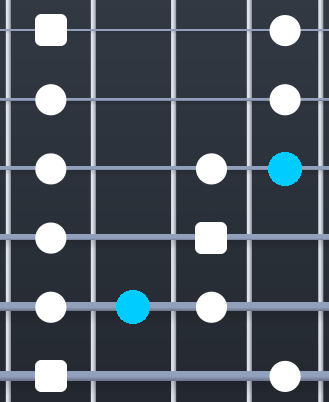
The square note positions represent the root note positions. The blue-colored note positions show the position of the ‘Blue’ notes.
To use the above scale shape, simply match the square note position with the root note you want to use.
For example, if you want to jam with a backing track in the key of A, you simply need to start the above scale shape at the fifth fret on the low E string.
A Blues Scale Diagram
Here is the fretboard diagram for the A Blues Scale up to the 12th fret:
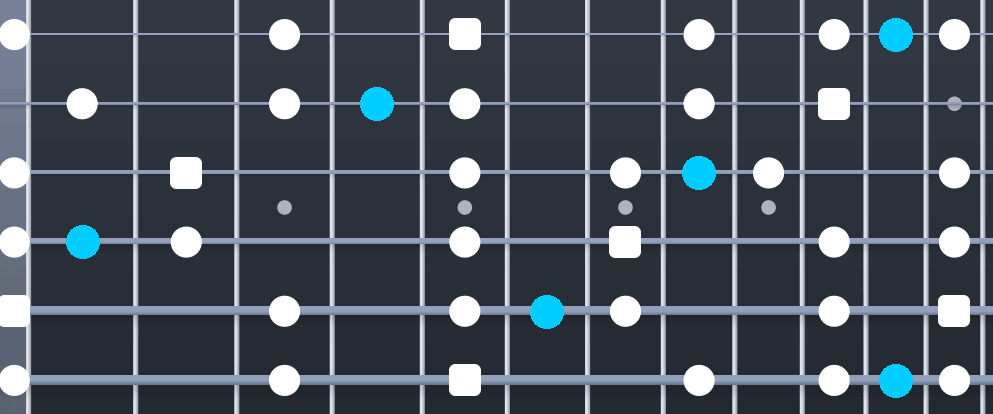
If you compare this diagram with the basic box shape diagram from earlier, it should be clear how the box shape forms part of the full scale.
Pay extra attention to the highlighted blue notes as those notes are the core part of getting a blues sound out of this scale.
If you were to skip playing those notes entirely, you’ll miss out on the distinctive blues sound you get from the Blues Scale.
E Blues Scale Diagram
Here is the E Blues Scale up to the 12th fret:
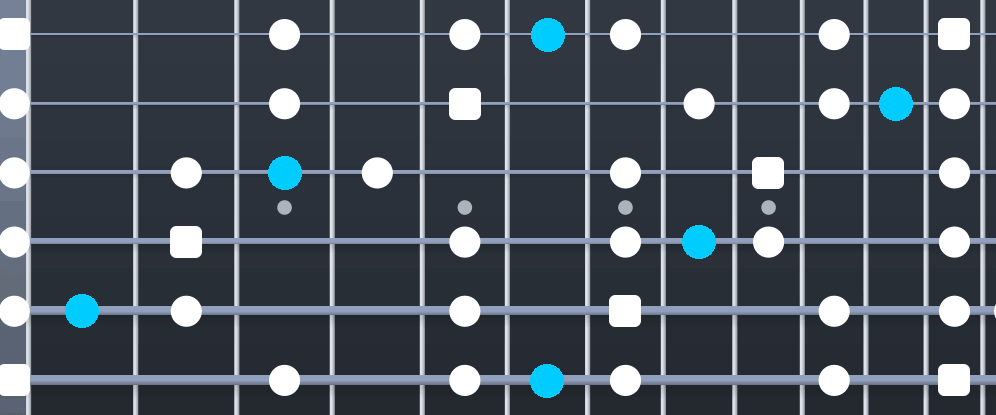
This time the basic box shape starts at the open strings. This means the same pattern can be used starting on the 12th fret, which is used in a lot of songs.
Songs Using the Blues Scale
There are plenty of songs that use the Blues Scale as well as countless jams and improvisations. Here are a couple of examples of the Blues Scale in action in songs along with Guitar TAB.
Sunshine of Your Love by Cream
The main riff of this song is the perfect example of the Blues Scale. This song uses the D Blues Scale, which would take the basic box shape as shown earlier and start it on the 10th fret.

In the above riff, you can see that the 11th fret is the Blue note from the scale.
This riff is one of the 14 Must-Know Easy Guitar Riffs, so check out the guide for more simple guitar riffs to learn.
Heartbreaker by Led Zeppelin
This is another simple example of the Blues Scale being used to create an iconic guitar riff.

The above riff uses the A Blues Scale, then later the riff shifts up to the B Blues Scale before moving back down to A.
Have a guess which of the above notes is the Blue note. By now, the Blues note should instantly stand out – especially if the notes around the Blue note are used as well.
In the above riff, the Blue note is the 1st fret on the D string. Get used to looking for three notes in a row (eg: 0 1 2) as a dead giveaway of a Blue note.
Beating Around the Bush by AC DC
This blistering-fast riff at 260 bpm is a great example of using the Blues Scale in an aggressive way.

The above riff uses the E Blues Scale, so compare it against the fretboard diagram from earlier to see how it uses the scale.
The way the riff bounces back and forth between the 1st and 2nd frets is no accident – this is a well-known way to get the most out of the Blue Note.
The 2nd fret (the fifth of the scale) is a very stable-sounding interval, while the 1st fret (the flat-fifth) is a very unstable interval. By bouncing back and forth between these two notes, it can create an interesting sound or feeling for a song.
Try coming up with a similar riff that bounces back and forth between the Blue Note and the fifth.
Black Magic Woman by Santana
Sometimes the Blues Scale is best used when you play it sparingly. Instead of focusing all the time on the Blue Note, try using it only once or twice to make it stand out.
Black Magic Woman by Santana mainly follows the D minor Pentatonic Scale. But in one descending scale run, you can hear Santana play the D Blues Scale and throw in the Blue Note:

If you play the above scale run, the Blue Note will instantly stand out when you hit it.
You might also notice that Santana skipped over the Blue note (13th fret on the G string) at the start of the scale run. By skipping the note earlier in the scale run, it makes the Blue Note on the 11th fret stand out.
If you’re used to improvising with the minor Pentatonic Scale, try to do something similar to this. Play with the Pentatonic scale as usual, then throw in a Blue Note or two and try to get those notes to stand out.
How to Practice the Blues Scale
There are a couple of ways you can practice the Blues Scale to learn it faster. For full details, check out this Guide on How to Practice Guitar Scales.
Memorizing the Notes
The first thing you should focus on is memorizing the notes used in the scale. Some guitarists do this by splitting the scale into positions, others memorize one string at a time focusing on intervals, while others use the scale formula.
Start by memorizing the notes in the minor Pentatonic Scale. Once you have done that, memorizing the Blues Scale is as simple as remembering to add in the Blue Note at the right positions.
Jamming Exercises
The best way to practice the Blues Scale is to use it in a musical way. Jamming and improvising using the scale is how you learn to use it and will be far better practice than running up and down scales exercises.
The two fretboard diagrams shown earlier show the A Blues Scale and the E Blues Scale. Practice using these scales along with suitable backing tracks.
For example, the below video gives a simple blues backing track in the key of A. Try improvising using the A Blues Scale over this backing track:
If you feel stuck for ideas on what to play, try playing some of the Blues Scale licks shown later in this guide.
If you’ve never improvised over a backing track before, check out this Beginner’s Lesson to Improvising.
As you play over the backing tracks, pay close attention to how the Blue Note sounds. Listen out for its distinctive sound and make sure you play around with the two notes surrounding the Blue Note to get the most out of it.
Blues Scale Licks
Here are some basic licks using the Blues Scale to give you an idea of how to use it. All of these licks are in the key of A, so compare them to the earlier fretboard diagram to see how they fit in the scale.
Try taking these licks and modifying them as you lick, then try to come up with your own bluesy-sounding licks.
Blues Lick Exercise 1
The idea with this lick is to experiment with bends. Take note of the two bends in this lick and what pitches they’re bending up to:

The first bend is bending up into the Blue Note. Guitarists do this all the time and it can have a dramatic effect on any lick you play.
Try varying the rhythm of this lick with slow and fast bends. Slowly bend up to the Blue Note and listen to how it sounds over a backing track.
The 1/4 note bend is an example of a microtonal bend. When you bend this note, you’re playing a pitch somewhere between the 8th and 9th fret. It’s up to you how far you bend this note.
The reason this bend is played on the 8th fret is that this note is the minor third of the scale (m3). Bending up from this pitch is very popular in blues as you’re bending up towards the Major third (M3). Try coming up with other licks that experiment with microtonal bends – especially around the minor and Major third notes.
Blues Lick Exercise 2
This is an extremely simple lick to get you used to listening to how the Blue Note fits in with the rest of the scale.
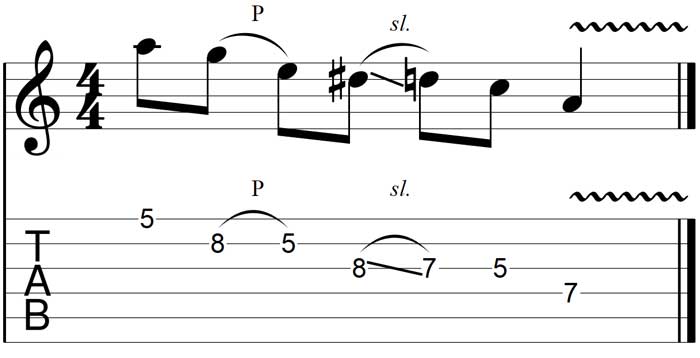
The Blue Note is often played as a passing note to add color to a scale run. In this example, the use of the pull-off and the slide help make the scale run sound more interesting.
If you were to pick each of these notes, it may sound a bit bland. Adding in techniques such as hammer-ons, pull-offs, slides, bends, vibrato, palm-muting, or staccato can help turn a boring-sounding scale run into something exciting.
Try coming up with a similar lick using an ascending scale run. Experiment with adding in different techniques to spice up the scale run and listen to how the Blue Note fits in.
Blues Lick Exercise 3
This lick is based on one of the most common licks you will hear in rock and blues. The only difference between this lick and the lick usually played is the very first bend.
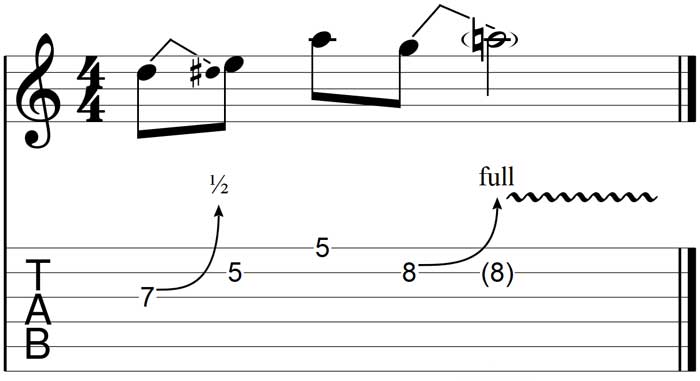
In a typical Pentatonic-based lick, the first bend would be a whole-tone bend. Changing that to a half-tone bend turns this Pentatonic lick into a Blues Scale lick.
Just like the first lick exercise, it is very common to continue this bend by moving up the strings as shown. Rock guitarists like to repeat the first three notes over and over, so try that at different speeds.
Have a close look at the pitch the last note is bending up to and holding. There’s a good reason why so many rock and blues licks end like this. See if you can figure out why (hint: what note is the bend playing and how does it fit with the rest of the scale?).
Blues Lick Exercise 4
The idea with this lick exercise is to get used to using bends and microtonal bends to add something interesting to a melody.

The first three notes are very close together in pitch, so you need to pay extra attention to your bending technique. Try to make the bends in the second bar match the pitches you heard in the first bar.
This lick is also a very basic example of a call and response lick. See if you can continue this lick a few more times to keep the call and response style going.
An easy way to start experimenting with this style of playing is to change the last couple of notes in a lick. Finish on a higher note for the ‘question’ or ‘call’ lick, then finish on a lower note for the ‘answer’ or ‘response’ lick.
Alternatively, if you know some basic music theory, end your ‘question’ licks on a non-chord-tone note to leave the listener hanging, then finish the ‘answer’ licks on a chord-tone note to give some resolution.
Blues Licks Tips
Here are some basic tips to help you get a better blues sound when coming up with your own licks:
- Experiment with bends: play around with full bends, half bends, quarter bends, and listen to how they change the feeling of what you’re playing
- Add in other passing notes: the Blue Note is only one example of how you can add notes outside of the ‘normal’ scale to add something unique to your playing. Experiment with adding in other notes outside of the scale
- Start out simple: if you listen to great Blues guitarists, many of the licks they play are incredibly simple. Try to come up with three-note licks and make each note count
- Listen to the backing track: match the speed and feel of what you’re playing to the style of the backing track. Learn to modify your licks to match the vibe of the backing track
- Practice call and response: listen to some blues songs and you’ll hear a clear call and response style between vocals and the lead guitar. Try to do something similar with your own playing
- There are no wrong notes: if you play a note and it sounds bad, see if you can make it work by playing that note again or playing around with bends in and out of that note. This is a great way to learn how to see the potential of each note instead of thinking about ‘right’ and ‘wrong’ notes
The key to a great blues sound is to use your ears. If something sounds good – do it again! It takes a lot of practice, but learn to use your ears and try not to rely on strict scale patterns.
Blues Scale FAQ
Here are some common questions you might have about the blues scale.
What Scales Should I Learn on Guitar for Blues?
If you want to play blues on guitar, you should learn the Minor Pentatonic Scale and the Blues Scale. Both scales are very similar but are commonly used by blues guitarists.
Why is the Blues Scale Used in Blues?
The Blues Scale is often used in blues music because it combines the quality of the notes from the Minor Pentatonic Scale with the tension of the added Blue Note. The Blues Scale works extremely well with blues music and similar styles.
Is the Blues Scale Major or minor?
The Blues Scale is a minor scale due to the minor third interval.
What Key is the Blues Played In?
Blues is most commonly played in the keys of E, A, and D. While the blues can be played in any key, guitarists tend to stick to keys that make use of the open strings. The best key for Blues is the key of E and there are countless blues songs and shuffles in this key.
Check out scale resources for the E Major Scale, A Major Scale, and D Major Scale.
Check out these useful scales resources to take your guitar playing further:
- Ultimate Guide to the Pentatonic Scale
- How to Practice Guitar Scales: Exercises, Charts, PDFs
- Guitar Scales Explained Simple
- How to Get Better at Guitar Scales
- What Guitar Scales and Modes Should You Learn?
- How to Break Out of the Pentatonic Box
- How to Memorize the Fretboard
